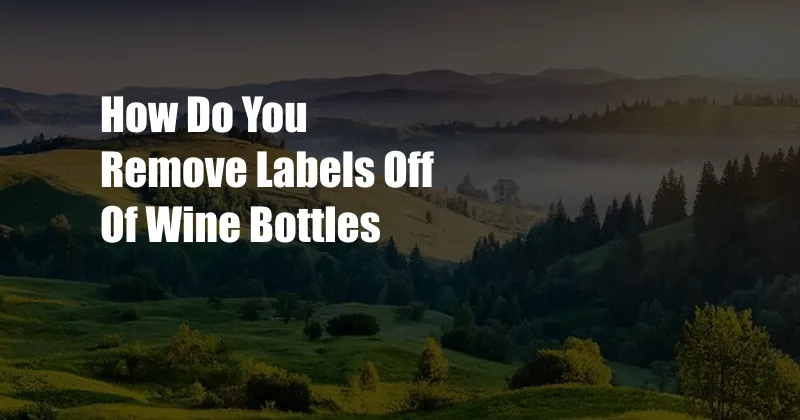
How to Effortlessly Remove Labels from Wine Bottles
Whether you’re a seasoned wine connoisseur or just starting to explore the world of wines, you’ll inevitably encounter the challenge of removing the labels from your favorite bottles. While some labels come off effortlessly with a gentle peel, others seem to be welded to the glass, leaving you frustrated and at a loss.
Fear not, dear reader! I’ve scoured the depths of wine wisdom and gathered a collection of tried-and-tested methods to help you conquer this labeling dilemma. From simple home remedies to advanced techniques, we’ll guide you through the art of label removal, ensuring that your wine bottles are as aesthetically pleasing as their contents.
Soaking It Away
One of the most effective and gentle methods of label removal is the soaking technique. Here’s how it works:
- Submerge the wine bottle in a large bowl or bucket filled with warm water. Ensure the water level is high enough to cover the label completely.
- Allow the bottle to soak for 30 minutes to several hours. The longer the soaking time, the easier it will be to peel off the label.
- Carefully lift the bottle from the water and gently start peeling the label from one corner. It should come off in large pieces, leaving minimal residue on the glass.
Heat and Peel
If soaking doesn’t do the trick, applying heat can soften the adhesive and make label removal a breeze. Here’s how to do it:
- Boil a small amount of water in a kettle or heat it in a microwave.
- Pour the hot water into a large bowl or container.
- Hold the wine bottle upside down over the steam rising from the hot water. Keep the bottle at a safe distance to avoid burns.
- The heat will soften the adhesive within minutes. Grasp the label’s edge and carefully peel it off.
Freezing It Off
For stubborn labels that resist both soaking and heat, freezing can be a surprisingly effective solution. Here’s the process:
- Place the wine bottle in a freezer for several hours or overnight. The extreme cold will cause the adhesive to become brittle.
- Remove the bottle from the freezer. The label should now be frozen solid.
- Carefully crack the frozen label with the edge of a knife or a bottle opener. The shattered pieces should peel off easily.
Commercial Solutions
If you prefer a more specialized approach, there are commercial products available to aid in label removal. These solutions typically contain enzymes or chemicals that break down the adhesive, making it easier to remove the label.
- Label Remover Solutions: These pre-mixed solutions are simply applied to the label and allowed to sit for a specified time before removing the label.
- Steamers: Label steamers generate a powerful steam that can penetrate the adhesive bond and soften the label.
Expert Tips and Advice
- Use a butter knife or a thin spatula to gently pry the label off the glass, especially if there’s residual adhesive.
- Avoid using abrasive materials like steel wool or scouring pads, as they can scratch the glass.
- If you’re dealing with delicate or vintage wine labels, consult a professional restorer to prevent damage.
- After removing the label, wipe the bottle with a damp cloth to remove any remaining adhesive.
- If you encounter any persistent adhesive residue, try using a mild dish soap or a rubbing alcohol solution.
FAQs
Q: Can I reuse wine bottles with the labels removed?
A: Yes, you can reuse wine bottles by removing the labels. However, ensure you thoroughly clean and sterilize the bottles before using them.
Q: Is it safe to remove wine labels with vinegar?
A: While vinegar can help remove some adhesives, it’s not recommended for wine bottles. Vinegar can etch the glass and potentially alter the wine’s flavor.
Q: How can I remove the label without damaging the bottle cap?
A: If the label extends over the bottle cap, try using a hair dryer to heat the adhesive around the cap. Gently peel back the label from the cap and use a damp cloth to remove any remaining adhesive.
Q: Can I use a razor blade to remove wine labels?
A: While a razor blade can be effective in removing labels, it’s not recommended due to the risk of scratching or cutting the glass.
Conclusion
Removing wine labels may seem like a trivial task, but with the right techniques and a bit of patience, you can transform your wine bottles into elegant vessels that showcase the beauty within. Whether you prefer the simplicity of soaking, the heat of steam, or the convenience of commercial solutions, there’s a method to suit every label and every wine lover. So, next time you find yourself captivated by a wine’s label, don’t hesitate to remove it and reveal the timeless allure of the bottle beneath.
Are you a wine enthusiast interested in learning more about wine etiquette and appreciation?